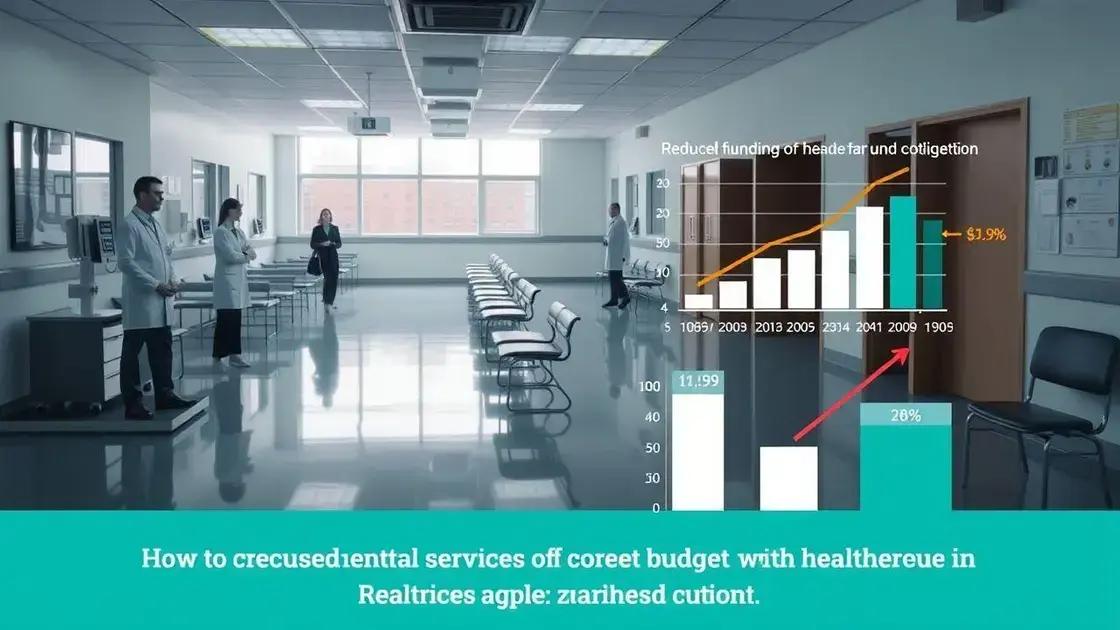Federal budget cuts: how they impact our lives

Anúncios
Federal budget cuts significantly impact communities by reducing funding for education, healthcare, infrastructure, and social safety nets, adversely affecting the quality of essential services and support systems.
Federal budget cuts can have far-reaching impacts that affect all of us, often in unexpected ways. Have you considered how these cuts shape the services and support systems we rely on daily?
Anúncios
Understanding federal budget cuts
Understanding federal budget cuts is crucial for grasping their wide-ranging effects on society. These cuts occur when the government reduces its spending levels, impacting various sectors.
Typically, federal budget cuts aim to manage national debt and deficits, but they can lead to significant challenges, particularly in essential services. For instance, they affect funding for schools, healthcare, and public safety.
Anúncios
How federal budget cuts impact different areas
These reductions can create a ripple effect throughout communities. Here are a few key areas impacted:
- Education: Budget cuts can lead to larger class sizes and fewer resources for students.
- Healthcare: Reduced funding may limit access to essential medical services and programs.
- Public safety: Cuts to police and fire departments may weaken local emergency responses.
While federal budget cuts are sometimes necessary, they often result in difficult choices about which programs to fund. The decisions made at the federal level have the potential to cause major changes at state and local levels.
Moreover, it’s important to acknowledge the role of the community in addressing these challenges. Local organizations often step in to fill gaps left by budget cuts, offering support to those in need. However, without adequate federal funding, sustaining these community efforts can become increasingly difficult.
The ongoing debate
There is ongoing discussion about the necessity and impact of federal budget cuts. Advocates for reduced spending argue that it is essential for fiscal responsibility. On the other hand, many believe that such cuts disproportionately harm vulnerable populations, leading to long-term consequences.
As the conversation around these cuts continues, understanding their implications can help individuals and communities prepare and respond to changes in funding and services. Engaging in advocacy for balanced approaches can also be a positive step toward ensuring critical services remain funded.
Historical context of federal budget cuts
The historical context of federal budget cuts provides valuable insight into their evolution and impact. Understanding the journey can help us recognize patterns in government spending and policy decisions.
These cuts have roots that trace back to various economic challenges. For example, during the late 1970s and early 1980s, the U.S. faced high inflation and recession. As a response, policymakers aimed to reduce federal spending, setting the stage for future cutbacks.
Key milestones in federal budget cuts
Several significant moments in history have marked substantial changes in federal budget policies:
- Post-World War II: After the war, the government shifted priorities from military spending to domestic programs.
- 1980s Reagan Administration: Major cuts occurred as tax reform and financial deregulations took priority.
- 2008 Financial Crisis: The crisis triggered another wave of budget cuts as a means to respond to the economic downturn.
In addition to economic factors, social and political pressures also influenced federal budget cuts. Public sentiment often sways decisions on funding for various social programs. For instance, while some advocate for reduced government spending, others argue for investing in essential services.
As policies continued to evolve, different administrations took varying approaches to handling budgets. Each era reveals the complex relationship between the economy and the federal budget, showing how priorities shift over time. In recent years, debates have intensified, reflecting ongoing concerns about fiscal responsibility and the need for funding vital services.
The role of advocacy and public opinion
The influence of advocacy groups cannot be understated in shaping federal budget policies. When communities unite to voice their concerns, it can lead to changes in funding for crucial projects. This dynamic is especially visible in debates over health care and education funding.
Moreover, public opinion plays a pivotal role. As people express their views, it creates pressure on lawmakers to reconsider proposed cuts. Understanding this historical context equips citizens to engage more effectively in discussions about future budgetary decisions.
How budget cuts affect education funding
Budget cuts have a profound impact on education funding, altering the landscape of schools and learning environments. When federal budget cuts occur, the effects can be felt in classrooms across the nation.
Schools often rely on federal funding to support programs critical for student success. Any reduction in this funding can lead to significant changes. For example, budget cuts may result in fewer teachers, larger class sizes, and diminished resources for students.
Consequences of budget cuts in education
The repercussions of these cuts are often severe and wide-ranging. Some of the key impacts include:
- Teacher layoffs: With reduced budgets, schools may be forced to let go of staff, affecting student-teacher ratios.
- Program reductions: Arts, music, and physical education programs may be cut, depriving students of valuable learning experiences.
- Less support for special needs: Funding cuts can reduce resources for students who require additional support, hindering their educational progress.
As schools strive to adapt to these changes, it often leads to a decline in overall educational quality. Teachers find it increasingly challenging to meet the diverse needs of their students without adequate support. This situation can create an environment where both teachers and students struggle to succeed.
Furthermore, community resources often feel the strain as families seek external support for their children’s education. Local organizations and nonprofits may try to fill the gaps left by budget cuts, but their resources are also stretched thin. This creates ongoing challenges for students who rely on those programs.
Looking ahead
The long-term effects of reduced education funding can hinder a student’s academic journey, limiting opportunities for higher education and future careers. Engaging stakeholders in the conversation about funding is key. Parents, teachers, and community members must advocate for sustained investment in education to ensure that all students receive the support they need.
As the discussion about federal budget cuts continues, understanding how they specifically affect education helps raise awareness and drive change. An informed community is equipped to defend the needs of schools and the students they serve.
Consequences for healthcare services

Budget cuts have serious consequences for healthcare services, affecting the quality and accessibility of medical care across the nation. When funding decreases, healthcare providers face tough decisions that can impact patient outcomes.
One major consequence is the reduction of available services. For example, clinics may have to limit hours or reduce staff, making it harder for people to get the care they need. This can lead to longer wait times for appointments and a decrease in preventative care services.
Impact on patient care
Healthcare budget cuts can create a ripple effect that harms patients. Here are some key areas affected:
- Increased wait times: Patients may experience longer delays in receiving critical treatments.
- Reduced access to specialists: Cuts can lead to fewer specialists available for consultations, limiting patient options.
- Limitations on essential programs: Programs that provide resources for low-income families can see cuts, decreasing access to necessary care.
The lack of funding can also affect the ability of healthcare facilities to maintain adequate standards. Hospitals may struggle to invest in new technologies or necessary renovations. As a result, the quality of care can decline, leaving patients with fewer choices.
Healthcare providers, including hospitals and clinics, often find themselves in a difficult position. They must balance budget constraints with the need to provide high-quality care. Many facilities try to maintain service levels by seeking alternative funding sources, but those options can be limited. In many cases, organizations must look to community support to fill the gaps left by budget cuts.
Long-term effects on public health
Over time, inadequate healthcare funding can lead to significant public health issues. Without access to necessary care, patients may delay seeking treatment for serious conditions. This not only affects individual health but can also lead to broader community health crises.
Understanding the link between federal budget cuts and healthcare services is vital to advocate for better policies. As communities become aware of these impacts, they can push for solutions that protect essential health services and ensure everyone has access to care.
Impact on infrastructure development
The impact of federal budget cuts on infrastructure development can be profound. As funding decreases, the ability of communities to maintain and build essential infrastructure is greatly challenged.
When budgets are tightened, projects that require significant investment often face delays or cancellations. This can include roads, bridges, public transportation systems, and utilities. Infrastructure projects often have a long timeline, meaning that cuts can lead to years of postponed improvements.
Key areas affected by budget cuts
Several critical areas of infrastructure development suffer when funding is reduced:
- Transportation: Road and bridge maintenance is crucial for safety and efficiency. Budget cuts can result in potholes and unsafe conditions increasing.
- Public transit: Cuts to transit funding can lead to fewer public transportation options, making it harder for people to commute to work or school.
- Utilities and services: Water and sewer projects often see cuts, which can hinder upgrades and maintenance vital for community health.
Moreover, when infrastructure projects are underfunded or shelved, the long-term economic growth of a community can stagnate. The state of roads and public transport plays a significant role in local businesses and job opportunities. Poor infrastructure can deter new investments, making it hard for areas to thrive.
Communities often try to fill these gaps through local funding or public-private partnerships, but these solutions may not always fully compensate for lost federal funding. With rising costs and demands, maintaining adequate infrastructure becomes increasingly complex.
Long-term implications
As infrastructure decays due to insufficient funding, communities may see increased traffic congestion and declining property values. These issues can lead to further financial strain on local governments, creating a cycle difficult to escape.
Understanding the consequences of budget cuts on infrastructure is crucial for communities striving to advocate for better funding solutions. Awareness can lead to increased public engagement and pressure on policymakers to prioritize infrastructure needs.
Effects on social safety nets
The effects of federal budget cuts on social safety nets are deeply concerning as they directly impact the most vulnerable populations in society. When funding is reduced, essential services that support individuals and families in need face significant challenges.
Social safety nets include programs such as food assistance, housing support, and unemployment benefits. These programs are critical for helping people during difficult times, and cuts can lead to dire consequences.
Key areas impacted by budget cuts
Several important aspects of social safety nets feel the strain during budget reductions:
- Food assistance programs: Reductions can limit access to food stamps and nutrition programs, making it harder for families to provide adequate meals.
- Housing support: With less funding, programs aimed at helping individuals secure affordable housing may see reductions, leading to increased homelessness rates.
- Healthcare access: Cuts can lead to fewer resources for mental health services and preventative care, impacting overall community health.
As these critical services are cut back, people who rely on them may struggle to meet basic needs. This creates cycles of poverty and hardship that can be tough to break. When families do not have access to food and housing, their health and well-being suffer, affecting children’s education and long-term outcomes.
Furthermore, local communities often attempt to fill the gaps left by budget cuts through charitable organizations. However, these groups often lack the necessary resources to meet the growing demand for services. As need increases, non-profits may struggle to provide adequate support, leading to further issues for those needing help.
The ripple effect on communities
When social safety nets weaken, community stability is also threatened. Increased insecurity can lead to higher crime rates and lower overall quality of life. Moreover, investments in social safety nets contribute to economic stability by increasing consumer spending and supporting local businesses.
In summary, the consequences of federal budget cuts on social safety nets reveal a clear need for advocacy and action. Understanding how these cuts affect individuals and communities can help foster conversations about how to protect and improve vital support systems.
Voices from the community
The voices from the community play a vital role in shaping responses to federal budget cuts. These perspectives highlight the real-life impacts of policy decisions and showcase the resilience of individuals and groups affected by funding changes.
Community members often share personal stories that illustrate how budget cuts influence daily life. Families may struggle to access healthcare, children might face challenges in education, and local organizations may find it hard to deliver essential services. Hearing these stories helps create a clearer picture of the consequences of cuts.
Personal experiences that matter
Many individuals use platforms to voice their concerns and experiences. Common themes include:
- Healthcare struggles: Individuals share how reduced funding has limited their access to necessary medical care, leading to health declines.
- Educational impacts: Parents express worries about overcrowded classrooms and the lack of resources for their children’s education.
- Community support challenges: Local organizations speak out about their difficulties in providing assistance to vulnerable populations.
These voices are crucial for raising awareness about issues arising from federal budget cuts. When community members come together to share their stories, it can create a greater sense of urgency and drive collective action.
Moreover, local media often highlight these voices, allowing a broader audience to hear about the struggles and needs within the community. This can lead to advocacy efforts, where residents work together to seek solutions and support.
Empowering communities through storytelling
By sharing experiences, communities can better advocate for themselves. Mobilizing local support networks and engaging with local government representatives can amplify their message. Grassroots movements often find strength in unity, making their voices louder and more impactful in discussions about budgetary decisions.
As concerns grow about the consequences of federal budget cuts, amplifying these voices can influence policymakers and lead to necessary changes. Understanding the community’s perspective fosters positive dialogue, encouraging more thoughtful decisions regarding funding priorities.
Looking to the future: potential solutions

Looking to the future, finding potential solutions to counter the effects of federal budget cuts is essential. Communities and policymakers are exploring innovative approaches to ensure essential services remain funded.
One way forward is by enhancing collaboration between public and private sectors. Engaging businesses and non-profit organizations can lead to partnerships that effectively address funding gaps. For example, companies can contribute through sponsorships or community service initiatives, directly supporting local needs.
Potential strategies to address budget cuts
Several strategies can help mitigate the impact of budget cuts on critical services:
- Advocacy for fair funding: Raising awareness about the importance of maintaining funding for essential programs can rally community support and influence policymakers.
- Grants and alternative funding sources: Exploring grants, crowdfunding, or community fundraising can create additional resources for local projects.
- Improving efficiency: Analyzing existing programs to find efficiencies can maximize the impact of available funds while maintaining service quality.
Additionally, community engagement is crucial for these initiatives to succeed. When residents are actively involved in discussions about budget priorities, they can voice their needs and support efforts to find solutions. Public forums, workshops, or online platforms allow for diverse input, fostering stronger community relationships.
As communities navigate the challenges posed by federal budget cuts, innovative ideas will be essential for crafting sustainable models. By focusing on collaboration and leveraging local strengths, it is possible to build resilience and adapt to changing circumstances.
Successful case studies
Looking at successful examples from other communities can provide inspiration. For instance, some towns have successfully formed public-private partnerships to maintain vital infrastructure, proving that collaborative approaches can be effective. Sharing these success stories can motivate others to take similar paths.
Ultimately, proactive solutions can help ensure that communities remain strong, despite the challenges that come with budget cuts. By working together and exploring new avenues, the future can look brighter for everyone involved.
FAQ – Questions About the Impact of Federal Budget Cuts
How do federal budget cuts affect education funding?
Federal budget cuts can lead to larger class sizes, fewer resources, and potential staff layoffs, negatively impacting the quality of education.
What are the consequences of budget cuts on healthcare services?
Budget cuts can limit access to healthcare, increase wait times, and reduce the availability of essential services for patients.
How do budget cuts impact community safety nets?
Cuts to social safety nets can result in reduced food assistance, housing support, and healthcare access, making it difficult for vulnerable populations to get help.
What are some potential solutions to address these budget cuts?
Potential solutions include advocacy for fair funding, enhancing public-private partnerships, and exploring alternative funding sources to maintain essential services.






